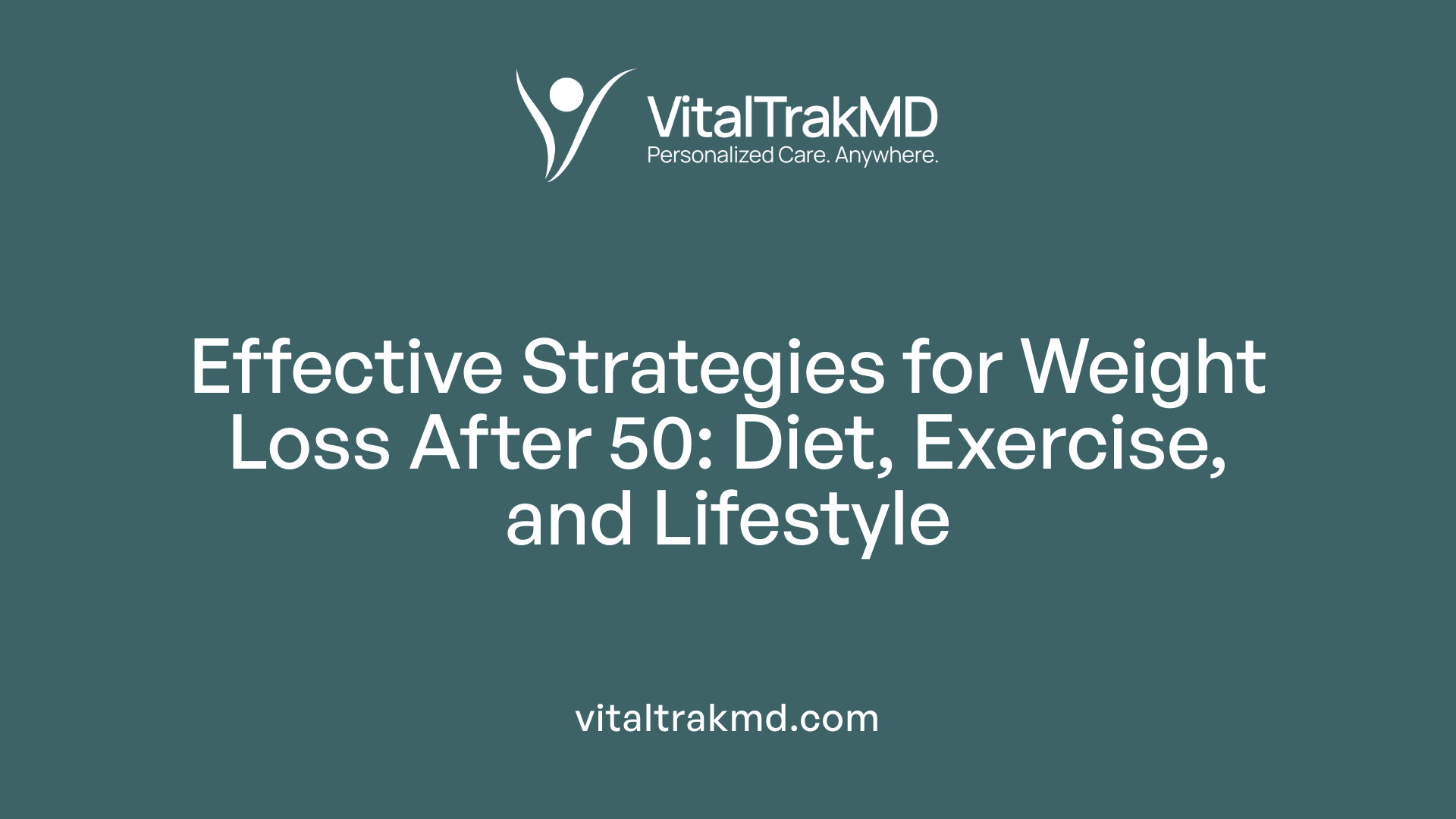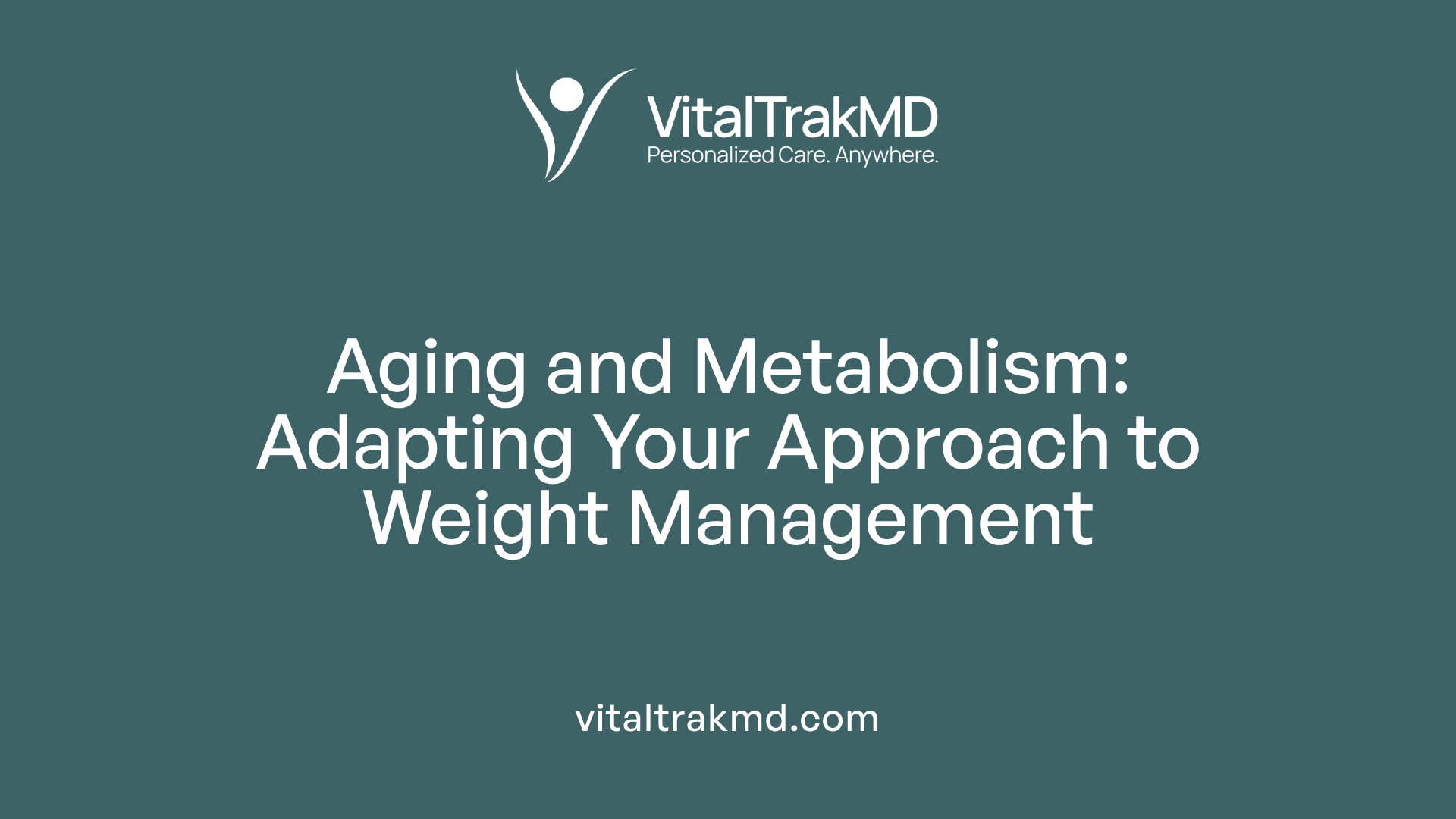Weight Loss Realities for Adults Over 50: What Works and What Doesn’t

Understanding the Challenges and Opportunities in Senior Weight Management
Weight loss after 50 presents unique challenges linked to physiological, hormonal, and metabolic changes that occur with age. Despite these obstacles, adopting age-appropriate, sustainable strategies can lead to significant health improvements and a better quality of life. This article explores what works, what doesn’t, and how adults over 50 can effectively manage their weight, emphasizing scientific evidence, practical tips, and common misconceptions.
Effectiveness of Approaches for Weight Loss Over 50

What are effective weight loss strategies for adults over 50?
Losing weight after age 50 can be more challenging due to natural metabolic slowing and loss of muscle mass. However, effective strategies focus on holistic lifestyle changes. A balanced, nutrient-rich diet plays a pivotal role. Emphasizing high-protein, fiber-dense foods such as lean meats, beans, vegetables, and whole grains helps preserve muscle and increase satiety, reducing overall calorie intake.
Reducing intake of added sugars, processed foods, and ultra-processed snacks is essential. These foods often contain empty calories and contribute to belly fat accumulation and insulin resistance. Incorporating more fruits and vegetables supports overall health and promotes satiety.
Physical activity is crucial. Combining aerobic exercises like brisk walking, cycling, or swimming for at least 150 minutes weekly with strength training exercises two to three times weekly helps combat muscle loss, raise metabolic rate, and burn fat. Full-body workouts including movements like squats, presses, pulls, hinges, and carries are recommended to maximize muscle engagement.
Behavioral modifications underpin long-term success. Setting S.M.A.R.T. (Specific, Measurable, Attainable, Realistic, Time-bound) goals provides clarity and motivation. Regular self-monitoring through weight logs or activity trackers enhances accountability. Engaging in support networks or working with professionals such as dietitians and trainers can sustain motivation.
Long-term adherence involves gradual weight loss—about 1 to 2 pounds per week—is sustainable and healthier. Small, consistent changes foster habits that last a lifetime.
Additionally, quality sleep (7-9 hours per night), effective stress management (e.g., mindfulness, breathing exercises), and proper hydration—with a daily intake of about eight glasses of water—are integral. Proper hydration not only supports metabolic functions but also aids in thermogenesis and energy conversion.
Overall, customizing these strategies to individual health conditions—such as arthritis, hormonal changes, or medication effects—is vital. Working closely with healthcare providers ensures safe, effective, and sustainable weight management tailored to aging bodies.
| Aspect | Recommendations | Additional Details |
|---|---|---|
| Diet | High-protein, fiber-rich, reduce sugars | Emphasize whole foods, unprocessed meals |
| Physical Activity | 150 min aerobic + strength training 2-3x/week | Full-body routines, variety, professional guidance |
| Behavioral Changes | Self-monitoring, SMART goals | Support groups, counseling, accountability tools |
| Sleep & Hydration | 7-9 hours sleep, 8 glasses water | Supports metabolism, stress reduction |
| Support | Medical consultation, ongoing support | Tailored plans addressing age-related changes |
These combined approaches foster healthier aging, reduce risks of chronic diseases, and promote overall well-being.
How Aging Influences Body Composition and Metabolic Rate

How do aging-related changes in body composition and metabolism affect weight management in adults over 50?
As people age, especially past 50, their bodies undergo notable changes that make weight management more challenging. One of the primary factors is the loss of muscle mass, a condition known as sarcopenia. Starting in the 40s and accelerating after age 50, muscle tissue gradually diminishes, leading to a decrease in basal metabolic rate (BMR). This reduction means the body burns fewer calories at rest, which can contribute to weight gain if calorie intake isn't adjusted accordingly.
Alongside muscle loss, there is an increase in fat accumulation, particularly visceral and abdominal fat. This shift in body composition occurs even if the overall weight or BMI remains stable. Visceral fat, located around internal organs, is strongly linked to higher risks of heart disease, diabetes, and other health issues. The redistribution of fat to the midsection also signifies metabolic and cardiovascular risks increasing with age.
The decline in BMR is partly due to decreases in organ size and tissue-specific metabolic activity, which lowers overall energy expenditure. Additionally, aging influences hormonal levels, with estrogen and testosterone declining significantly in women and men, respectively. These hormonal changes promote fat storage, especially in the belly area, and reduce muscle synthesis.
Factors impacting energy expenditure include lifestyle habits like decreased physical activity, poor nutrition, stress, and inadequate sleep—common issues among those over 50. Less physical activity not only accelerates muscle loss but also decreases daily calorie burn, further complicating weight management.
In this context, managing weight effectively in adults over 50 involves more than just monitoring calories. It requires strategies aimed at preserving muscle mass through strength training and high-protein diets, reducing visceral fat via targeted exercise, and addressing hormonal and metabolic changes with medical guidance when necessary. Overall, understanding these age-related shifts helps tailor interventions that improve body composition, maintain metabolic health, and support healthy aging.
Lifestyle Changes That Promote Weight Loss and Overall Well-being

What lifestyle modifications support weight loss and overall health for adults over 50?
Maintaining a healthy weight after 50 involves a holistic approach that includes various sustainable lifestyle changes. Central to this is adopting a balanced, nutrient-rich diet that emphasizes whole, unprocessed foods. This diet should include plenty of fruits and vegetables, lean proteins such as fish and poultry, whole grains, and healthy fats from sources like nuts, seeds, and olive oil. Limiting added sugars, refined carbohydrates, and processed foods is crucial, as these are linked to increased belly fat and insulin resistance.
Regular physical activity plays a vital role in supporting weight management and overall health. Experts recommend at least 150 minutes of moderate aerobic activity, like brisk walking or cycling, spread throughout the week. Incorporating strength training exercises at least twice weekly helps counteract age-related muscle loss, known as sarcopenia, and boosts metabolism. Flexibility and balance exercises, such as stretching or yoga, improve mobility and reduce fall risk.
Adequate sleep, typically 7 to 9 hours per night, is essential in regulating hunger hormones and reducing cravings. Managing stress through techniques like mindfulness, deep breathing, or hobbies such as gardening and dancing can lower cortisol levels, which are associated with abdominal fat storage. Using mindfulness during eating, avoiding late-night snacks, and staying hydrated further support weight control.
Social support is a powerful motivator. Engaging with friends, family, or community groups during activities like walking clubs, dance classes, or cooking groups can increase adherence to healthy habits. Enjoyable activities not only make health routines sustainable but also improve mental well-being.
Focus on optimizing body composition rather than weight alone. Efforts should prioritize reducing visceral or abdominal fat—a major health risk—while preserving and building lean muscle mass. This dual focus improves metabolic health, decreases inflammation, and reduces risks for chronic diseases such as diabetes and heart disease.
By integrating these lifestyle modifications, adults over 50 can promote successful weight loss, enhance physical function, and enjoy a higher quality of life, emphasizing health and vitality at every age.
Setting Realistic Goals and Managing Expectations in Senior Weight Loss

How can adults over 50 set realistic weight loss goals and manage expectations?
As adults age past 50, losing weight becomes more challenging due to natural physiological changes like decreased muscle mass and hormonal shifts. To set achievable goals, it’s important to focus on gradual progress. A typical and practical target is losing about 5% to 10% of current body weight, which can significantly improve health outcomes such as blood pressure, cholesterol, and blood sugar levels.
While some individuals may aim for greater weight loss, it’s vital to tailor goals to personal health status, activity level, and medical advice. Consulting healthcare providers is essential to develop a safe and effective plan, especially for those with existing joint issues, hormonal imbalances, or chronic conditions. They can help customize calorie intake, recommend suitable exercise routines, and monitor progress.
To support sustainable weight loss, adopting gradual strategies is recommended. For instance, reducing daily calorie intake by approximately 200 calories—through healthier food choices and portion control—combined with regular physical activity like strength training and cardio, can lead to steady progress without overwhelming the body.
Setting goals that are Specific, Measurable, Attainable, Realistic, and Time-bound (SMART) makes it easier to stay motivated and evaluate progress. For example, aims like losing one to two pounds per week or reaching a specific weight within a set timeframe help maintain focus and provide clear milestones.
Long-term success depends on maintaining a focus on overall health and functionality rather than appearance alone. This includes improving mobility, energy levels, and managing chronic health conditions. By keeping expectations realistic and emphasizing health benefits over quick fixes, seniors can build confidence and foster habits that promote lasting weight management.
Hormonal and Metabolic Challenges in Weight Loss for Seniors
Are there specific hormonal or metabolic challenges that affect weight loss in adults over 50?
Yes, there are distinct hormonal and metabolic hurdles that make weight management more difficult for those over 50. As people age, natural declines in hormones such as estrogen, testosterone, DHEA (dehydroepiandrosterone), and growth hormone occur. These hormonal shifts influence body composition, leading to a reduction in lean muscle mass and an increase in fat, especially visceral fat around the abdomen.
Muscle tissue is highly metabolically active, burning more calories at rest compared to fat tissue. The loss of muscle mass, a process known as sarcopenia, thereby decreases resting metabolic rate, making it easier to gain weight and harder to lose it.
Furthermore, aging hormones like estrogen and testosterone play a role in fat distribution. As their levels decline, fat tends to accumulate around the midsection, increasing health risks such as heart disease and diabetes.
Metabolic slowdown also ties into increased insulin resistance with age. This condition hampers the body's ability to regulate blood sugar, leading to higher blood insulin levels that promote fat storage, particularly in the abdominal area.
Another factor influencing metabolic health is chronic low-grade inflammation often seen in older adults. This inflammation is related to increased visceral fat and is associated with the production of inflammatory cytokines, which further impair insulin signaling and exacerbate metabolic dysfunction.
Adipokines like leptin and adiponectin, which help regulate appetite and insulin sensitivity, also undergo changes, contributing to the difficulty of weight loss.
Despite these challenges, lifestyle strategies such as regular strength training, adequate caloric restriction, and a diet rich in nutrients can help improve hormonal balance and metabolic health.
Incorporating physical activity that boosts muscle mass not only increases calorie expenditure but also improves insulin sensitivity, which is crucial for effective weight management.
Overall, understanding these hormonal and metabolic changes helps tailor weight loss approaches for older adults, emphasizing the importance of comprehensive, personalized plans that address these specific issues.
The Critical Role of Diet and Exercise in Senior Weight Management
What is the role of diet and exercise in weight management for adults over 50?
For individuals over 50, maintaining a healthy weight can be more challenging due to natural metabolic slowing, loss of muscle mass, hormonal shifts, and lifestyle factors. Nonetheless, a strategic combination of diet and physical activity remains the foundation of effective weight management.
A balanced diet rich in vegetables, fruits, lean proteins, healthy fats, and whole grains supports weight loss and overall health. These nutrient-dense foods help control calorie intake, enhance satiety, improve metabolic health, and compensate for hormonal changes that tend to increase fat accumulation, especially around the abdomen.
Regular physical activity, including aerobic exercises like walking or cycling, strength training, and flexibility routines, not only promotes calorie burn but also helps preserve muscle and bone density. Given that muscle mass declines about 1% annually after age 50, maintaining or increasing muscle tissue boosts metabolism, making weight management more attainable.
In addition to formal exercise, small lifestyle modifications—such as increasing daily movement, opting for stairs instead of elevators, and engaging in activities that are enjoyable—can significantly improve adherence. These daily habits help sustain calorie expenditure and support physical and mental well-being.
Focusing on body composition, particularly preserving muscle while reducing visceral fat, offers a more accurate health assessment than weight alone. An emphasis on muscle health supports functional ability and reduces the risk of chronic diseases such as osteoporosis, type 2 diabetes, and cardiovascular problems.
Ultimately, integrating a nutritious diet with an active lifestyle tailored to aging needs promotes safe and sustainable weight management, fostering better health outcomes and quality of life in later years.
| Strategy | Details | Additional Benefits |
|---|---|---|
| Balanced diet | Vegetables, fruits, lean proteins, healthy fats | Improves satiety, metabolic health, counters hormonal shifts |
| Aerobic exercises | Brisk walking, cycling, swimming | Enhances cardiovascular health, weight loss |
| Strength training | Resistance exercises, weight lifting | Preserves muscle mass and bone density |
| Flexibility routines | Yoga, stretching | Maintains mobility, reduces injury risk |
| Small lifestyle changes | More daily movement, taking stairs, enjoyable activities | Builds sustainable habits, improves mental health |
| Focus on body composition | Muscle preservation, visceral fat reduction | Overall health improvement and functional independence |
By adopting these integrated approaches, adults over 50 can better navigate age-related challenges, optimize their health, and enjoy an active, fulfilling life.
Scientific Findings and Tips for Sustainable Weight Loss in Older Adults
Are there specific tips or scientific findings that help older adults lose weight sustainably?
Research indicates that older adults can achieve sustainable weight loss through a combined approach that emphasizes caloric reduction along with increased physical activity. A typical goal involves aiming for a 5-10% reduction in body weight, which has been shown to significantly improve metabolic health and decrease levels of inflammation that often increase with age.
Maintaining muscle mass and bone density is critical during weight loss efforts. Strength training exercises are highly recommended because they help counteract sarcopenia—the age-related loss of muscle mass—and support bone health. These exercises not only help preserve physical function but also boost resting metabolic rate, allowing for more efficient calorie burning.
In addition to exercise and diet, pharmacotherapy can offer added benefits for older adults struggling with weight management. Medications such as glucagon-like peptide-1 (GLP-1) receptor agonists—including semaglutide and liraglutide—are emerging as effective options. These drugs promote weight loss by suppressing appetite and improving glucose regulation, which can be particularly beneficial for seniors with insulin resistance or type 2 diabetes.
While the long-term effects of these medications are still being studied, early evidence suggests they are effective tools for supporting weight loss without substantial muscle or bone loss. It’s beneficial for older adults to consult healthcare providers to determine their suitability.
Overall, long-term research remains limited, but current data supports the idea that small, consistent, and well-monitored weight loss can promote healthy aging. Importantly, strategies should be highly individualized, focusing on each person's health status, functional capacity, and body composition goals. This personalized approach helps ensure that weight management efforts are sustainable and beneficial.
In sum, combining calorie control, strength training, possibly pharmacotherapy, and personalized care forms the backbone of successful weight management for aging populations. These methods can help older adults maintain vitality, prevent age-related diseases, and enjoy an improved quality of life.
Addressing Misconceptions About Weight Loss in the Elderly
What misconceptions exist about weight loss in older adults, and how can they be addressed?
Many believe that significant weight loss in later years is either impossible or unnecessary. Others think that restrictive diets are the only way to shed pounds after 50. These misconceptions can discourage older adults from pursuing healthy weight management strategies.
In truth, weight loss at any age is achievable with the right approach. Adults over 50 can effectively lose weight by combining nutrient-rich diets with regular physical activity. Focused efforts on maintaining muscle mass through strength training are vital, as muscle tissue is more metabolically active than fat tissue, helping to preserve metabolism.
One common myth is that all fats and carbs are harmful. Research shows that emphasizing healthy fats—such as those found in fish, nuts, and olive oil—and whole grains like oats and brown rice supports weight management and overall health. These nutrients contribute to satiety and provide essential nutrients needed for aging bodies.
However, weight loss efforts must be careful to avoid unintentional malnutrition. As appetite often decreases with age, it’s essential to ensure adequate intake of high-quality proteins, vitamins, and minerals. Nutritional deficiencies can impair immune function, muscle health, and overall vitality.
Debunking fad diets or extreme restrictions is important. Instead, a balanced, personalized approach focusing on sustainable habits tends to yield better results. This involves integrating regular physical activity—combining aerobic, strength, flexibility, and balance exercises—and adopting a diet that includes plenty of fruits, vegetables, lean proteins, and whole grains.
Health risks like sarcopenia (muscle loss) and osteoporosis can be mitigated with proper nutrition and resistance training. These habits support functional independence, energy levels, and quality of life.
In summary, addressing misconceptions involves educating older adults that weight management is both possible and beneficial at any age, provided the methods are safe, realistic, and focused on health rather than mere weight loss. Promoting positive, sustainable strategies encourages healthier aging and reduces the stigma often associated with weight and aging.
Changes in Body Fat Distribution and Their Health Consequences
How does body fat distribution change with age, and what are the health implications?
As individuals grow older, their body experience notable shifts in how fat is stored and distributed. Typically, there is an increase in fat accumulation around the abdominal area, particularly as visceral fat, and a decrease in subcutaneous fat located in the hips, thighs, and buttocks. This redistribution often occurs regardless of overall weight or body measurements, meaning even people with a normal weight can experience unhealthy fat shifts.
The increase in abdominal visceral fat—fat stored deep within the abdominal cavity—poses serious health risks. It is metabolically active and secretes inflammatory substances that contribute to insulin resistance, type 2 diabetes, and cardiovascular disease. This type of fat also raises levels of harmful cholesterol and promotes inflammation, further exacerbating cardiovascular risks.
In addition to subcutaneous fat changes, aging is associated with the accumulation of fat within vital organs such as the liver, muscles, and bone marrow. This intra-organ fat affects organ function, increasing the risk of conditions like osteosarcopenic obesity—a combination of bone loss, muscle wasting, and fat gain—and elevates the risk of fractures and other serious health issues.
Impact of hormonal changes
Hormonal fluctuations play a significant role in these fat redistribution patterns. The decline in estrogen during menopause in women accelerates fat accumulation in the abdomen. Similarly, decreasing testosterone levels in men contribute to increased visceral fat deposition. These hormonal shifts influence regional fat storage, making it more challenging to maintain a healthy body composition.
Assessing these age-related changes in body composition requires advanced imaging techniques such as MRI and CT scans, which can precisely measure the distribution and amount of fat within the body. Standard assessments like BMI or waist circumference may not fully capture the nuanced shifts, underscoring the importance of targeted interventions.
Health risks associated with abdominal and internal fat
The presence of excessive visceral and organ fat is linked to higher risks of metabolic and cardiovascular conditions, including hypertension, atherosclerosis, and inflammatory diseases. Visceral fat is especially pathogenic because it releases free fatty acids and inflammatory cytokines that can enter the bloodstream and affect distant tissues.
In summary, aging is characterized by a distinctive redistribution of body fat, with increased visceral and organ fat that heightens health risks. These changes are driven by hormonal alterations and lead to complications such as insulin resistance, heart disease, and increased fracture risks. Recognizing and addressing these shifts through targeted lifestyle and medical interventions are crucial for promoting healthier aging.
Long-Term Strategies and Lifestyle Habits for Healthy Aging
Successfully managing weight after 50 hinges on understanding the complex interplay of aging-related physiological changes and adopting evidence-based, sustainable strategies. Emphasizing a balanced diet, consistent physical activity—including strength and aerobic training—and behavioral modifications can lead to meaningful health improvements while reducing risks associated with visceral fat and muscle loss. Setting realistic goals, working closely with healthcare providers, and debunking myths about aging weight loss are essential for success. By prioritizing long-term habits—such as adequate sleep, stress management, hydration, and social connections—adults over 50 can achieve not only weight management but also enhanced overall well-being, functional independence, and vitality. Remember, healthy aging is an ongoing journey grounded in informed choices and perseverance.
References
- Losing Weight After 50: Top 20 Expert Tips - AARP
- The 20 Best Ways to Lose Weight After 50 - Healthline
- The Mayo Clinic Diet: A weight-loss program for life
- Intermittent Fasting for Women Over 50: What You Need to Know
- Weight Loss Basics for Older Adults: The SilverSneakers Guide
- 22 Simple Ways to Lose Weight After 50 - Men's Health
- Why is it so hard for women over 50 to lose weight? | Endeavor Health
- Losing weight after 50: 15 tips to change body composition and ...
- This Is How To Lose Weight the Right Way — and Keep It Off
- Weight loss: 6 strategies for success - Mayo Clinic
Recent articles
Want to Feel Better and Live Healthier?
Join hundreds of patients taking control of their health with personalized care that fits their life – not the other way around.
Rated 4.8/5 by 32+ customers







